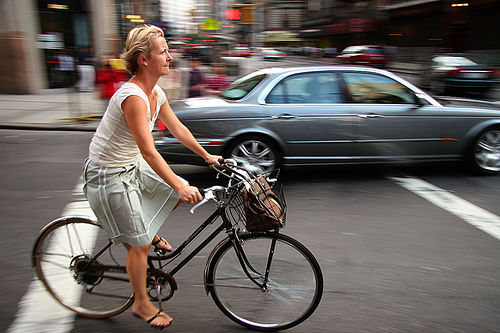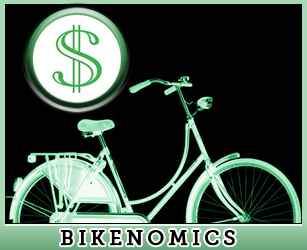 This is the ninth column in a series focusing on the economics of bicycling.
This is the ninth column in a series focusing on the economics of bicycling.
That uptick in bicycling numbers you’ve been hearing about nationwide?
It’s mostly men.
A recent paper looked at cycling demographic trends and found that, on average, nearly all the new riders on U.S. roads in the past 20 years have been men between the ages of 25 and 64.
Meanwhile, the rate of women on the roads has held steady, with 24 percent of bike trips nationwide made by women in 2009 (according to the national travel survey for that year).
There’s plenty of local variation. In Minneapolis, 44 percent of riders are women. In Portland, it’s 39 percent. In Chicago, on the other hand, the number of women on bikes is decreasing. In Germany, half of all riders are women. In the Netherlands, it’s more than half. In Lima, Peru, it’s 2 percent.
What’s going on? Why don’t more U.S. women ride bikes?
The two theories you hear bandied about the most are fear and fashion.
A widely cited 2009 study found that women are more likely to choose to ride on quiet residential streets, while men are more likely to choose direct routes even if they have heavier traffic. Women are an “indicator species” for cycling, this study concludes, and that cities can cajole greater women ridership by building safer-feeling bike infrastructure.
Much is also made of another concern women often express in surveys — that cycling to work will impede our ability to conform to professional norms in clothing, makeup, and hairstyles. The response can be seen in the proliferation of the “Cycle Chic” brand, tweed rides, and the commingling of bicycling and high fashion in advertising.
 She’s determined to get ahead on a bike.Photo: killthebird
She’s determined to get ahead on a bike.Photo: killthebird
There’s plenty of truth in both the fear and fashion theories. But before we commit to blaming women’s transportation practices on our timidity and vanity, I think it’s worth looking at some other potential factors.
Like the economy.
Women are more likely than men to be poor. We still don’t earn equal pay — as recently as 2009, women made 77 cents for each dollar earned by men doing equivalent work. Other factors range from the kind of work available to women to hiring bias against pregnant women and mothers.
Despite the economy of bicycle transportation, households with lower incomes are less likely to have access to bikes. Barriers to bicycling include the cost of bicycle purchase when all one’s transportation dollars are tied up in a car, cultural barriers such as perception and police profiling, and lack of access to safe infrastructure in neighborhoods with low housing costs.
Another barrier: Bicycling takes time. And this is something that, by the numbers, women have less of than men. In 2004, employed women reported an average of one more hour of housework per day than their employed male counterparts. These same employed women reported twice the time spent caring for young children. Employment status being equal, we have more household duties and are far more likely than men to be caregivers for aging relatives.
These kinds of responsibilities add up to more complicated transportation needs. Women make more trips than men, with diverse kinds of trips chained together. And twice as many trips as men’s are at the service of passengers — that is to say, the school drop-off, soccer practice, and the play date wedged in there between the grocery run and the commute to work (see pages 15 and 16 of this paper). No wonder the minivan is inextricably linked with motherhood in America.
We can hope that one day none of these duties will be tied to gender. Until then, statistically, if you’re a woman, biking is going to be less accessible to you than for your statistical male counterpart.
If you only need to go to work and come home again, with little to carry and no stops along the way, then riding fast on fast roads is fine — maybe even a welcome release from the stresses of the day. But whether you’re male or female, when you add a kid or two and a stop for groceries and the need to arrive at the other end smelling okay, you’d better believe you’re going to take a mellower route if there is one, and the car if there isn’t. (And about that fear thing: Women are more likely than men to admit to fear, for instance, about going the dentist. Just because men don’t rank safety concerns highly in a survey doesn’t mean they are excited to ride on bad infrastructure.)
Bicycling is, in much of the car-centric U.S., either a privilege or a punishment. That’s why more women aren’t bicycling. It isn’t because we’re fearful and vain; it’s because we’re busy and broke and our transportation system isn’t set up for us to do anything but drive.
Among advocates, there are few signs of a clear national strategy emerging to address the gender gap. There is quite a bit of focus on fear — that of “women, children, and seniors” as well as the more generic “interested but concerned” potential cyclist. But this hardly seems like a winning way to introduce the public and politicians to the joys of bicycling.
Meanwhile, instead of directly addressing the economic and labor disparities that impact people’s ability to ride a bike for transportation, advocacy campaigns too often seem stuck on urging us, particularly women, to just give bicycling a try anyway. Oh, and why not buy some expensive lifestyle goods while we’re at it?
If there’s anything American women don’t
need, it’s a guilt trip, whether it’s about our personal fitness, our looks, our fears, or our responsibility to the global good.
What we do need is the same that that men need — roads that are good places for bikes, and lots of other people out there bicycling and making them even safer.
We need bikes we can use to carry kids and cargo, and we need men to go ahead and use them too.
We need to not blame ourselves personally or be blamed for not being able to immediately throw away our car keys.
We need to demand advocates and politicians have the guts to work for more than incremental change. When they don’t, we need to get angry.
We need a world in which bicycling isn’t about gender and in which nobody has to write articles like this one.
We need to know how to point out, loud and clear, what equity looks like and what it doesn’t, at home, at work, and on the road.
Bonus: Watch Elly Blue talk about women and cycling.



